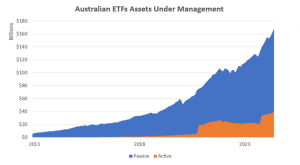Passive is massive: ETF investors still heavily favour index strategies
By Tony Kaye, Senior Personal Finance Writer
ETFs
More than 85% of investor inflows into ETFs are going into index-tracking funds.
Index-tracking exchange traded funds (ETFs) are continuing to capture the vast bulk of investor inflows on the Australian Securities Exchange (ASX), despite a surge in active fund listings.
Investors added a further $6.7 billion into ASX-listed ETFs over the month of July, up from $2.5 billion in June and $1.93 billion in May, taking total industry assets under management to a record $208.75 billion.
Research by Vanguard shows that, as at 31 July 2024, index funds had captured around 86% of all ETF investor inflows on the ASX in 2024.
That is, out of around $17.55 billion in total ETF inflows over the first seven months of 2024, $14.99 billion had flowed into ASX-listed index funds.
The remainder of ETF investor inflows up until the end of July, about $2.54 billion, largely reflected the recent conversion of an unlisted actively managed fund into an ETF product. This transaction alone added $2.49 billion.
Index funds are often described as “passive” funds because they invest in all or most of the securities within a market index with the objective of mirroring the index’s returns rather than outperforming market returns. By contrast, “active” funds do not track an index and their investment managers aim to outperform markets.
There’s a flurry of activity to list new ETFs and it’s important for investors to do their homework before investing to really understand the inner workings of products.
— Adam DeSanctis,
Head of ETF Capital Markets, Asia-Pacific
ETFs population continues to grow
There were 357 ETF products listed on the ASX as at 31 July compared with 351 at the end of June and 325 at the start of 2024.
Vanguard’s research shows that $168.2 billion was invested across the 243 index-tracking funds as at the end of July, which equated to 81% of the ETF industry’s total assets under management. By contrast, $40.55 billion (19%) was invested across the 114 active fund products.
Source: Vanguard. Data as at 31 July 2024.
At the end of July 2023 active funds were managing around $22.5 billion in assets versus the $126.77 billion in index funds.
But breaking down the total assets growth within active funds, Vanguard’s research shows that the majority has actually been as a result of the conversions of unlisted actively managed funds into listed ETFs. New investor inflows into actively managed funds have been small.
“When you look at the monthly data and break down the investor cash flows into passive (index) ETFs versus cash flows into active products, you can see that index-tracking funds have been taking the lion’s share of inflows over a long period of time,” says Adam DeSanctis, Vanguard’s Head of ETF Capital Markets, Asia-Pacific.
“In 2023, for example, index funds captured $16.17 billion of investor inflows versus the $1.89 billion of inflows in active funds.
“You can also see that the growth in active assets under management has been quite staggered, mostly as a result of several large companies having chosen to turn their unlisted funds into ETFs. They are the same funds as before, but now they’re trading through an active ETFs structure.”
A large number of small products
Mr DeSanctis says that another statistic worth noting is that at the end of July, out of the total ETFs population on the ASX, there were more than 80 products with less than $20 million in assets under management.
By contrast, the Vanguard Australian Shares Index ETF (VAS) received $736 million in investors inflows just in July, taking its total assets under management to $16.05 billion.
“There are quite a lot of very small ETF products on the ASX which typically have very low trading volumes. As such, investors should consider ETF trading costs, such as the bid-ask spread and the management expense ratio (MER) when deciding where to invest assets as these costs can be higher for smaller funds.
“Additionally, some of the management costs on these products are relatively high, in some cases well above 1% compared to products with very low fees below 10 basis points.
“There’s a flurry of activity to list new ETFs and it’s important for investors to do their homework before investing to really understand the inner workings of products,” Mr DeSanctis says.
“It’s evident that passive index funds are where the bulk of the ETF industry’s cash flows are heading as more Australians use them as the core pillars of their portfolios to track the broad index returns from different markets.”
Important Information
Vanguard Investments Australia Ltd (ABN 72 072 881 086 / AFS Licence 227263) (“Vanguard”) is the issuer of the Vanguard® Australian ETFs. Vanguard ETFs will only be issued to Authorised Participants. That is, persons who have entered into an Authorised Participant Agreement with Vanguard (“Eligible Investors”). Retail investors can transact in Vanguard ETFs through Vanguard Personal Investor, a stockbroker or financial adviser on the secondary market.
We have not taken your objectives, financial situation or needs into account when preparing this publication so it may not be applicable to the particular situation you are considering. You should consider your objectives, financial situation or needs, and the disclosure documents for Vanguard’s products before making any investment decision. Before you make any financial decision regarding Vanguard’s products you should seek professional advice from a suitably qualified adviser. A copy of the Target Market Determinations (TMD) for Vanguard’s financial products can be obtained at vanguard.com.au free of charge and include a description of who the financial product is appropriate for. You should refer to the TMD of the relevant Vanguard products before making any investment decisions. You can access our IDPS Guide, PDSs Prospectus and TMD at vanguard.com.au or by calling 1300 655 101.
Past performance information is given for illustrative purposes only and should not be relied upon as, and is not, an indication of


